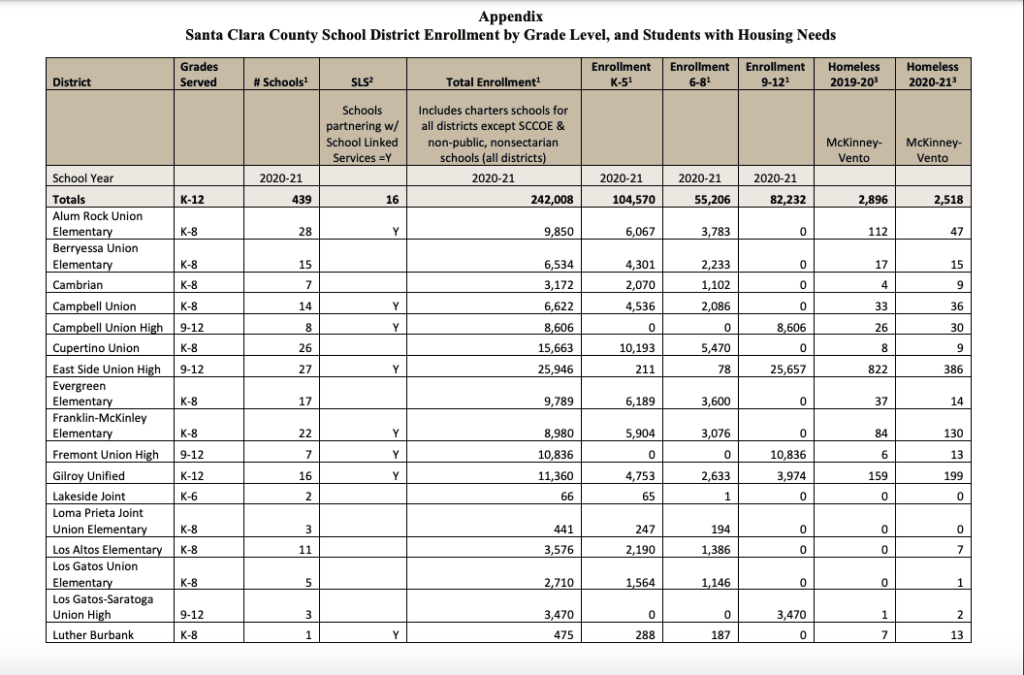The number of homeless students dropped in Santa Clara County during the COVID-19 pandemic, but some districts are seeing an uptick in the number of students struggling with housing this school year.
The number of homeless students in the county declined by 13% between the 2019-20 and 2020-21 school years, according to a report published in October from the Santa Clara County Executive’s Office. As children return for in-class learning that percentage appears to trend the other way, as school districts report a growing number of unhoused students.
“The realities of COVID have put more people in that situation,” said Glenn Vander Zee, superintendent of East Side Union High School District. “We’re seeing levels that are higher, not lower.”
Santa Clara County defines students as homeless if they qualify for services under the McKinney-Vento Homeless Assistance Act—federal legislation designed to increase access to school for children struggling with housing. The report uses data submitted by school districts to the state.
The county report, which used data from school districts, shows the overall number of homeless students spread across the county’s 32 school districts dropped from 2,896 to 2,518. The decline was uneven, as half of the districts such as Morgan Hill Unified School District saw homeless student numbers increase during the 2020-21 school year. Other educators have noticed an uptick in the number of students who lack stable housing.


School officials blame COVID-19 for exacerbating housing problems for many students, but the high cost of housing is also a factor. Lanae Bays, spokesperson for Morgan Hill Unified School District, told San José Spotlight many students classified as homeless are living in places that lack permanency, such as motels, trailer parks or shelters.
“This is the category a large number of our students fall into,” she said. Morgan Hill Unified had 533 homeless students in 2019-20; last school year it increased to 694, or about 30% according to the county report.
Children lack permanent shelter
The pandemic school year numbers may be skewed because thousands of students were forced to stay at home and do distance learning. This may have made it more difficult for school districts to accurately capture data on the number of students struggling with housing.
“I think many advocates are worried that we could be experiencing undercounting,” said Tara Sreekrishnan, trustee for the Santa Clara County Board of Education. She noted this trend occurred statewide even prior to the pandemic.
Historic investments from the state—including the eviction moratorium and Project Homekey, which provided unhoused people with shelter at motels—may have prevented a number of students from ending up in the streets, Sreekrishnan told San José Spotlight.
As the pandemic winds down, California has let protections like the eviction moratorium lapse. The loss of those guardrails shows housing insecurity is on the rise in some school districts.
“This year, we already have 209 homeless students enrolled,” said Katie Rodriguez, manager of the health and family support programs at San Jose Unified School District. “That’s higher than we would usually see this time of year.”
San Jose Unified has a contract with the Bill Wilson Center and has two case managers who are available to work with students and their families if they’re interested in enrolling for McKinney-Vento services. The center also helps parents connect with jobs.
Rodriguez told San José Spotlight it’s imperative to help parents get employment. But this can be tricky if their children are exposed to COVID-19 and the family is forced to quarantine.
“So some people may not be employable for that reason,” Rodriguez said. “I think that’s a major thing affecting homelessness that isn’t quite captured in the data.”
Vander Zee told San José Spotlight that East Side Union High School District has 401 active students enrolled who are classified as homeless. The district added 11 social workers this year for a total of 28, which Vander Zee said is a sign the demand for additional resources is growing, not shrinking. The district is always ready to partner with the county to tackle issues like housing insecurity, but he said there are a multitude of competing educational needs that worsened during the pandemic that require heavy lifting.
“We’re hopeful that the state and federal government does recognize this issue, and its impact, and could provide some funding to address the needs of these students,” Vander Zee said. “Because the issues of credit recovery and learning loss, as well as mental health issues, are equally present across our systems.”
Contact Eli Wolfe at [email protected] or @EliWolfe4 on Twitter.



Leave a Reply
You must be logged in to post a comment.